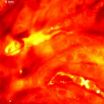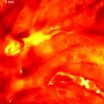Cellular 'power grid' failure triggers abnormal heart rhythms after a heart attack
'Heart attack in a dish' model offers glimpse inside cardiac cells during, after heart attack
2014-10-09
(Press-News.org) VIDEO:
The 'heart attack in a dish' experiment reveals that the mitochondria--or cellular powerhouses--of heart muscle cells flicker and oscillate following heart attack and disrupt the heart's entire electrical system...
Click here for more information.
Heart attack survivors often experience dangerous heart rhythm disturbances during treatment designed to restore blood flow to the injured heart muscle, a common and confounding complication of an otherwise lifesaving intervention.
Now a duo of Johns Hopkins researchers working with rat heart cells have shown that such post-heart attack arrhythmias are likely triggered by something akin to a power grid failure inside the injured cardiac cells. This power failure, the team found, is caused by disruption to the cells' mitochondria — the tiny powerhouses that fuel all cell life — when they become destabilized during the "resuscitation" period after a heart attack and trigger chaotic cell-to-cell signaling that interferes with the heart's entire electrical network.
The experiments, described ahead of print in the Journal of Molecular and Cellular Cardiology, offer what scientists believe is a first-of-a-kind detailed glimpse into the chain of events that occur inside the cells of the heart muscle during and after a heart attack. The findings, the research team says, can advance efforts to make heart attack treatment safer.
"Prompt treatment with stents or a balloon angioplasty to open up blocked arteries and restore blood flow to injured areas of the heart muscle is life-saving, yet paradoxically it can also increase the risk for potentially fatal arrhythmias," says Soroosh Solhjoo, Ph.D., a cardiology postdoctoral fellow at the Johns Hopkins University School of Medicine. "We believe our findings not only provide insights into the genesis of these electrical anomalies, but also illuminate a possible way to prevent them."
The experiments reveal that the sudden loss of energy supply to the heart cells and the subsequent rapid "reboot" during treatment causes mitochondria to falter and trigger a whirlwind of aberrant electrical signals. These chaotic signals quickly ripple throughout the entire heart, wreaking havoc in the cell-to-cell electrical signaling needed to keep the heart beating normally.
To mimic the energy starvation of heart muscle during a heart attack, the researchers created a "heart attack in a dish" by covering a thin layer of rat heart cells with glass to cut off the supply of oxygen and nutrients. Then, using a powerful microscope that magnifies and lights up the electrical circuitry of the cells, they watched the chain of events that unfolded inside them. Like a rolling blackout observed from a space satellite, the mitochondria — the cells' energy generators — began flickering out. As mitochondria ceased their energy production, heart cells gradually went motionless.
When the researchers lifted the glass, allowing oxygen and nutrients to flow back in — much as would be the case during reperfusion treatment with stents for example — the mitochondria flickered back to life. But instead of lighting up all at once, they resumed energy production haltingly — a process the researchers described as oscillation. Like sub-optimally fueled engines, these wavering mitochondria produce energy intermittently. As a result, the underpowered heart cells fire weakly and chaotically, forming a tiny cluster of misfiring muscle tissue, which creates a roadblock in the heart's circuitry. When an electric signal hits such a roadblock, it gets rerouted.
"The disrupted electric impulse gets diverted to neighboring cells, causing them to misfire as well," says Brian O'Rourke, Ph.D., professor of cardiology at the Johns Hopkins University School of Medicine. "Then, the aberrant signal can propagate in abnormal circuitous routes within the heart muscle, eventually leading to full-blown fibrillation." Fibrillation is a life-threatening arrhythmia in which the heart squirms and quivers instead of pumping rhythmically.
When the researchers pretreated the heart cells with a derivative of the sedative drug benzodiazepine before subjecting them to conditions that mimic a heart attack, the cells' mitochondria managed to regain normal function quickly, in effect restoring a steady supply of energy that prevented the cells from misfiring. Developing drugs that stabilize mitochondrial energy production, the team says, could help preserve cardiac function following a heart attack.
In their experiments, the researchers noted that the mitochondria of heart cells that lost oxygen and nutrient supply for a half-hour recovered smoothly. However, cells that were deprived of oxygen and nutrients for an hour had a bumpier recovery, marked by mitochondrial flickering and chaotic electrical signaling. Although the parallels in timing may be merely coincidental, the investigators say, the finding echoes the "golden hour" standard for heart attack treatment established by clinicians. Patients who undergo treatment within that window have much better recovery.
INFORMATION:
The research was funded by the National Institutes of Health under grants R01HL105216 and R37HL54598.
[Attachments] See images for this press release:


ELSE PRESS RELEASES FROM THIS DATE:
2014-10-09
This news release is available in German. The Ebola epidemic in West Africa appears to be spiralling out of control. More than ever, local and global health authorities want to know how the epidemic will develop and, above all, how to prevent it from spreading further. Certain parameters help them to determine this, such as the reproductive number, which is the average number of infections caused by a single infected individual. The incubation and infectious periods are also highly relevant; i.e. the time from infection to the onset of symptoms and the time from onset ...
2014-10-09
Antimicrobial usage in animals in Denmark continued to increase in 2013 – mainly due to an increased use in pigs. However, antimicrobial use in pigs is still 12% lower than in 2009. In general, livestock received very little of the critically important antimicrobials, which are used to treat humans. These findings appear in the annual DANMAP report from Statens Serum Institut and the National Food Institute, Technical University of Denmark. DANMAP is the Danish integrated antimicrobial resistance monitoring and research programme.
In 2013, the total use of antimicrobials ...
2014-10-09
This news release is available in German. Only recently, the UN Climate Summit came together in New York to further address the necessary measures to protect the Earth from a dramatic climate change. It has long been recognised that an increase of the average temperature will cause rising oceans and thus flooded landscapes. Particularly, regions close to the coasts are endangered. While it is well known that climate change has increased average temperatures, it is less clear how temperature variability has altered with climate change.
Postdoctoral fellow George Wang, ...
2014-10-09
The risk of having another stroke is higher if patients, after dilation of their blood vessels in the brain, not only receive clot-inhibiting drugs, but also have small tubes called stents inserted. However, studies have provided no hint of a benefit from stenting, which is also referred to with the abbreviation "PTAS". This is the conclusion reached in the rapid report of the German Institute for Quality and Efficiency in Health Care (IQWiG), as published on 9 October 2014.
Stents are supposed to prevent restenosis
Blood vessels in the brain that are narrowed or blocked ...
2014-10-09
Scientists at the University of Southampton have identified key characteristics that enhance a nanoparticle's ability to penetrate skin, in a milestone study which could have major implications for the delivery of drugs.
Nanoparticles are up to 100,000 times smaller than the thickness of a human hair and drugs delivered using them as a platform, can be more concentrated, targeted and efficient than those delivered through traditional means.
Although previous studies have shown that nanoparticles interact with the skin, conditions in these experiments have not been sufficiently ...
2014-10-09
Conventional estimates for the collapse of the Aegean civilization may be incorrect by up to a century, according to new radiocarbon analyses.
While historical chronologies traditionally place the end of the Greek Bronze Age at around 1025 BCE, this latest research suggests a date 70 to 100 years earlier.
Archaeologists from the University of Birmingham selected 60 samples of animal bones, plant remains and building timbers, excavated at Assiros in northern Greece, to be radiocarbon dated and correlated with 95.4% accuracy using Bayesian statistical methodology at the ...
2014-10-09
VIDEO:
Learn more about our research into the coast and how it can boost health and wellbeing.
Click here for more information.
People who live close to the coast are more likely to meet physical activity guidelines than inland dwellers, finds a new study released today.
The research involved participants from across England and describes a particularly noticeable effect on western – but unexpectedly not eastern – coasts of the nation.
Publishing their findings ...
2014-10-09
Scientists at The University of Manchester have used a new way of working to identify a new gene linked to neurodegenerative diseases such as Alzheimer's. The discovery fills in another piece of the jigsaw when it comes to identifying people most at risk of developing the condition.
Researcher David Ashbrook and colleagues from the UK and USA used two of the world's largest collections of scientific data to compare the genes in mice and humans. Using brain scans from the ENIGMA Consortium and genetic information from The Mouse Brain Library, he was able to identify a ...
2014-10-09
A new measurement of dark matter in the Milky Way has revealed there is half as much of the mysterious substance as previously thought.
Australian astronomers used a method developed almost 100 years ago to discover that the weight of dark matter in our own galaxy is 800 000 000 000 (or 8 x 1011) times the mass of the Sun.
They probed the edge of the Milky Way, looking closely, for the first time, at the fringes of the galaxy about 5 million billion kilometres from Earth.
Astrophysicist Dr Prajwal Kafle, from The University of Western Australia node of the International ...
2014-10-09
PITTSBURGH, Oct. 9, 2014 – National guidelines for the cleaning of certain gastrointestinal (GI) scopes are likely to be updated due to findings from UPMC's infection prevention team.
The research and updated disinfection technique will be shared Saturday in Philadelphia at ID Week 2014, an annual meeting of health professionals in infectious disease fields.
"Patient safety is our top priority," said senior author Carlene Muto, M.D., M.S., director of infection prevention at UPMC Presbyterian Hospital. "We are confident that the change from disinfection to sterilization ...
LAST 30 PRESS RELEASES:
[Press-News.org] Cellular 'power grid' failure triggers abnormal heart rhythms after a heart attack
'Heart attack in a dish' model offers glimpse inside cardiac cells during, after heart attack



